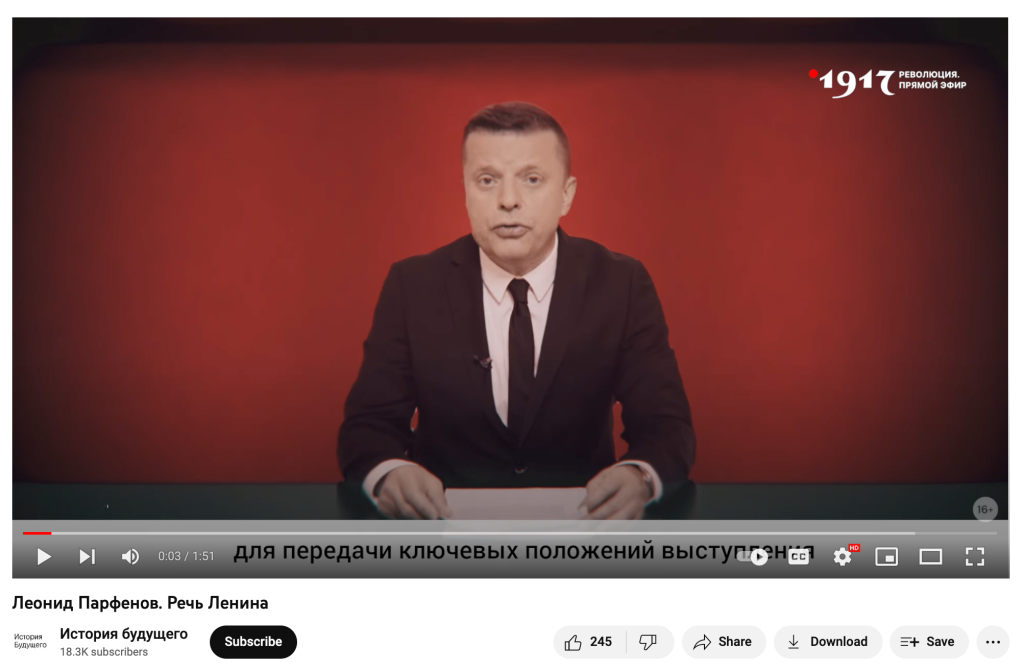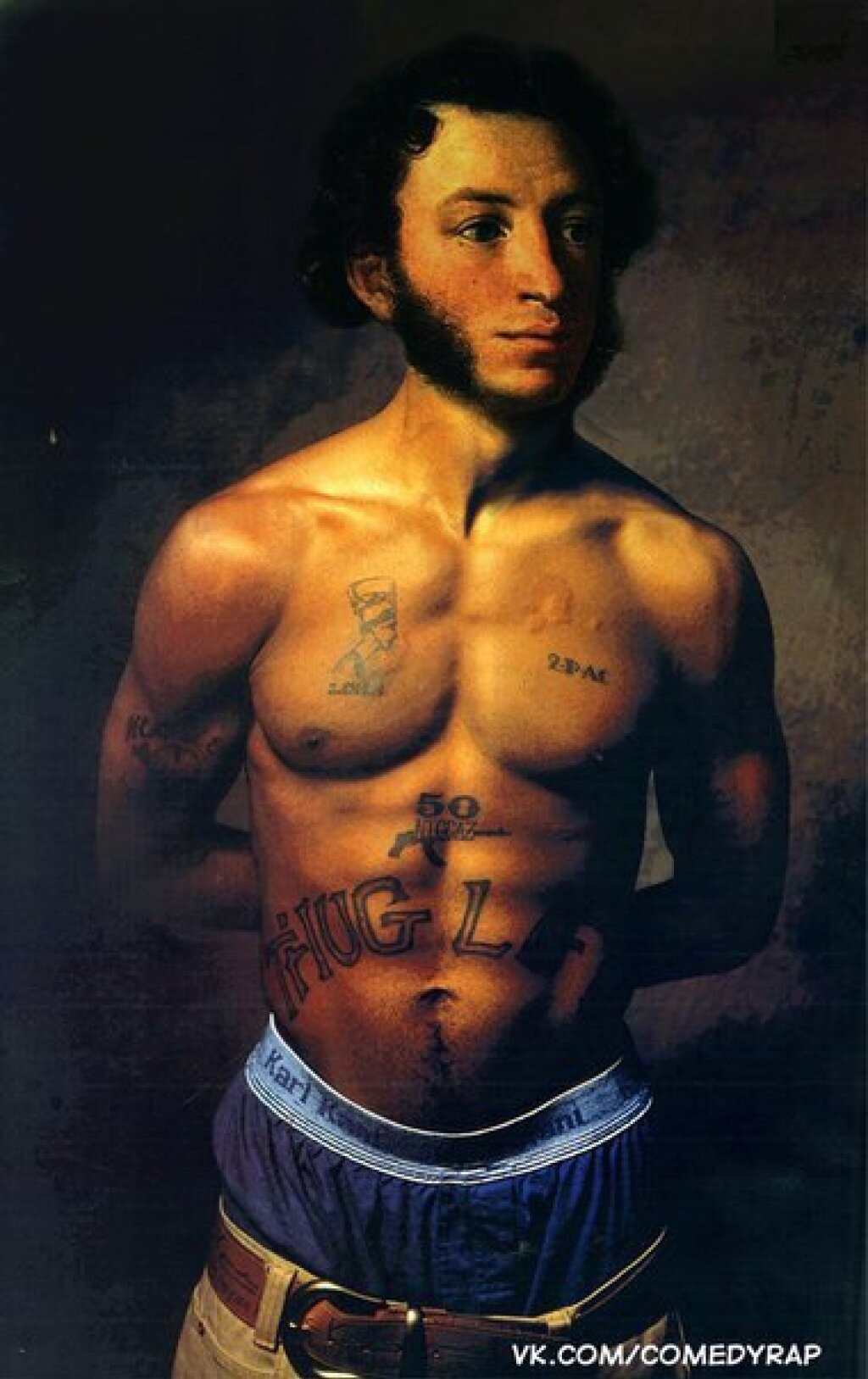The Jordan Center stands with all the people of Ukraine, Russia, and the rest of the world who oppose the Russian invasion of Ukraine. See our statement here.
Dasha Prokhorova is a first-year PhD student in the program in Slavic Languages & Literatures at the University of Washington.
Above: A still from a video of Leonid Parfenov reading Lenin's address of November 7, 2017 for Project 1917 – Free History
During his 2012 Address to the Federal Assembly, Vladimir Putin claimed, “Russia did not begin either in 1917, or in 1991. We have a single, uninterrupted history spanning over a thousand years.” According to Putin’s mythological view of the past, Russia’s invasion of Ukraine represents a key step in re-claiming a timeless empire. Mythology not only distorts history—with harmful consequences—it also leaves no room for interpretation. The ongoing war presents yet another signal of Russia’s desperate need to come to terms with its history, without erasure or the grip of fantasy.
A digital archive commemorating the Russian Revolution, Project 1917 – Free History, offers a rare opportunity for such open memory discourse, which is critical in light of the Russian state’s disregard for the centenary in 2017. By embracing a dual mode of creative dissidence and alternative education, the project facilitates an interactive and interpretive experience of history, illustrated through the lens of everyday life and narrated by a multiplicity of voices.
In November 2016, Mihkail Zygar, former Editor-in-Chief of television channel Dozhd, launched Project 1917 together with a group of 40 historians, journalists and screenwriters. By integrating 1500 archival sources, including letters, memoirs, and newspaper clippings, into the format of an open-access social media platform (which is also available in English), Zygar’s goal was to present history as a set of important stories covered from different sides in the context of a familiar genre.
The site’s colorful home page offers users several modes of navigating archival materials. One can browse by timeline, subject area, and historical figure. Users gain access to the “profile pages” of nearly 1500 individuals at various levels of historical prominence, from the emperor and his political opponents, to ballerinas and artists, to female soldiers and peasants. Each profile page features a portrait of the historical figure shaded in bright neon colors reminiscent of Andy Warhol’s pop-art style. Scrolling down the page, one finds a daily (and sometimes hourly) breakdown of the individual’s everyday thoughts and behavior. Through this format, historical figures become increasingly relatable, and complex subject matter more penetrable, for modern-day users.
In Project 1917, commonplace occurrences and observations co-exist with breaking news-style historical events, similar to a Facebook newsfeed. In her 1994 book Common Places, Svetlana Boym wrote that banality dominates everyday life: “we do not write novels but notes or diary entries that are always frustratingly or euphorically anticlimactic.” Project 1917 makes the apparently mundane and insignificant highly visible, contesting mono-causal master narratives inherited from the Soviet era.
Looking at the entries for December 29, 1917, a user will see, among other things, poet Anna Akhmatova’s update about her attendance at a nightly gathering of poets, a special post advertising the Bolshoi Theater premiere of Camille Saint-Saens’s Samson and Delilah, and Tsar Nicholas II’s commentary about changes in the weather. The former emperor ruminates about details of everyday routines and spends the morning cutting wood to warm up the bath.
On the one hand, the post de-conventionalizes the persona of the ex-emperor by focusing on his everyday life in exile. On the other hand, for those familiar with the Romanovs' ultimate fate, this post is quite shocking because the matter-of-fact tone clashes with the knowledge that the former tsar is about to be murdered, along with his entire family. In other words, users of the site have full agency to interpret this post according to their erudition and desire. Notably, most comments on the post focus on the fact that Nicholas didn’t avoid physical labor, rather than on his place in political history.
Societies often lack foresight ahead of major historical events. Zygar notes that the project “allows the reader to see the world through the eyes of historical figures and understand how they felt living through these events, not knowing how things would end.” By presenting archival materials in their original form, the project disrupts the process of telling history from the perspective of everything that happened consequently, which can distort lived reality. The fact that the Revolution’s “foundation story” was altered several times after 1917 demonstrates that history was being told primarily through a shifting ideological lens, rather than through authentic lived experience.
In Dreamworld and Catastrophe (2000), Susan Buck-Morss wrote that “when an era crumbles, ‘history breaks down into images, not into stories.’” Rather than presenting a “finished” form of the past, Project 1917 effectively maintains a fragmented structure of its materials, thus alternating between the potentiality of telling a coherent historical narrative and offering fragments of cultural memory. On their own, individual diary entries of poets, artists, journalists and revolutionaries offer authentic snapshots of their lives, framed through their daily thoughts and concerns, friendships and romances. Conceptualizing the experience of a particular day often had less to do with "revolutionary dreams" than with everyday moments, a reality to which present-day users can relate.
The project’s approachable format also forcefully challenges the power of mythology as a mechanism that replaces reflection with a false sense of historical authenticity. The opponent of Project 1917 is not alternative tellings of the story of the Revolution per se, but larger-than-life television reenactments of Soviet history. In response to costume drama-style representations of the Revolution like the state-funded TV series Demon of the Revolution (2017) or Trotsky (2018), Project 1917 chooses to connect the contemporary consumer to the period via verbal posts. Those posts that include a visual component feature contemporary media personalities reading breaking news from 1917.
For example, Lenin’s iconic speech of November 7, which trumpeted the Bolsheviks' triumph in the October Revolution, is delivered by contemporary journalist Leonid Parfenov. The creators of the project defuse the fantasy potential of the historical image in order to bring it as close as possible to the present-day delivery of breaking news. This creatively constructed bridge between past and present constitutes an alternative, and more productive, mode of mythmaking.
Project 1917 also gives voice to the repressed and the forgotten; the fall of the Romanov dynasty, after all, started with women protesting the senseless war and food shortages on what was to become International Women’s Day. Women are featured prominently under the “Characters” heading, and the struggle for women’s rights is attributed a dedicated subject hashtag: “#all people are sisters.” A featured post by Alexander Shliapnikov describes the beginning of the mass street protests led by women-workers marching from one factory to another gathering support. The site highlights a range of female politicians, including Alexandra Kollontai for the Bolsheviks, Ekaterina Breshko-Breshkovskaia for the Socialist Revolutionaries, and Sofia Panina for the Constitutional Democratic Party. Instead of flattening the past by exclusively focusing on the male “stars” of history, Project 1917 captures the complexity of Russian society at the turning point in its history through diversification of gender, class, and ethnic representation.
Boym characterized the alternative public spheres established during the 1960s-80s as a kind of “‘counter-memory’ that laid a foundation of democratic resistance” in Soviet society. In today’s Russia, where government propaganda consistently denies society’s inherent complexity, Project 1917 offers a space that supports civil discourse and challenges official narratives. Only when history belongs to the people and authentically reflects how they lived can societies hope to move forward.



